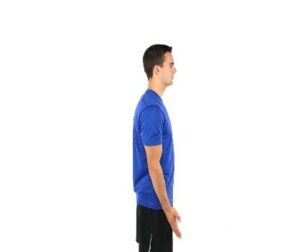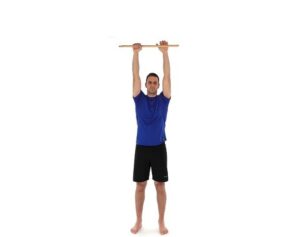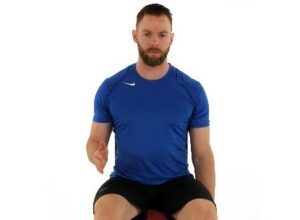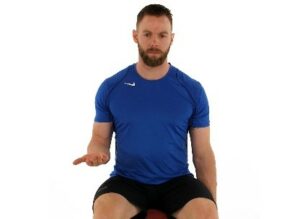- Reference Number: HEY-1288/2022
- Departments: Orthopaedics, Physiotherapy
- Last Updated: 1 September 2022
Great Staff – Great Care – Great Future
Introduction
This leaflet has been produced to give you general information. Most of your questions should be answered by this leaflet. It is not intended to replace the discussion between you and the healthcare team, but may act as a starting point for discussion. If after reading it you have any concerns or require further explanation, please discuss this with a member of the healthcare team.
What is a fracture of the Distal Radius?
The x-rays you had following your injury show that you have a broken wrist bone (or radius). A broken bone may also be referred to as cracked or fractured – these terms mean the same thing.
Your fracture is in a good position (not displaced) and should heal well if the advice below is followed.
How should it be treated?
This injury can be treated in a removable cast or wrist splint for 5 weeks, this will provide the support needed for the fracture to heal and will help relieve any pain you may feel. Simple medication such as paracetamol or NSAIDS (non-steroid anti-inflammatories) may help to control your pain. Contact your GP practice or pharmacist about medication options.
After 5 weeks, the cast can be removed without requiring a further consultant review.
It is really important to note that smoking will delay the healing process and so should be avoided. Contact your GP Practice or go to www.smokefree.nhs.uk for more information.
What should I do in the first few days?
Complete rest is not advisable. Use your hand as normally as possible, as your comfort allows, for daily tasks such as dressing, eating meals etc. If you are given a removable cast, care should be taken not to get this wet.
It is normal for the hand to be painful and swollen following this injury. However, although a normal reaction, swelling which stays in the hand too long, becomes very dense and sticky (fibrous) and can result in long term stiffness. To prevent this occurring you can:
- Keep your hand elevated above your heart to reduce swelling
- Move all your fingers and thumb regularly through their full range of movement.
Exercises to do whilst in the cast/splint
Arm exercises are very important; you should move your shoulder, elbow and fingers regularly to prevent stiffness at these joints. The exercises below can be performed 4 times daily.
1. Support your elbow on a table with your wrist straight and fingers pointing towards the ceiling.

Bend your fingers into your palm as tightly as you can. Hold the stretch 10 seconds.
Now stretch your fingers as wide as you can. Hold the stretch for 10 seconds.
2. Remove the arm from the sling and straighten it down by your side.


Now bend the elbow as much as possible.
Repeat 10 times slowly in each direction
3. Bend your elbow and tuck it into your side.

Turn your palm as far as possible upwards without moving your elbow. Feel the stretch and hold for 10 seconds.
Now turn your hand back over so your palm faces downwards, feel the stretch and hold for 10 seconds.
4. Shoulder flexion

Hold a long stick in both your hands.
Allow your unaffected arm to help your affected arm lift forward and upward as high as possible.
In the early stages, you may find this easier laid down.
You will have been told how long to wear the cast or splint after which time you can remove it yourself. No further X-ray will be needed.
When can I drive again?
You will not be insured to drive whilst you are in wearing a cast or splint. We advise it should be safe to return to driving when:
- You are no longer wearing the cast or splint
- You can comfortably grip the steering wheel, move the gear stick, pull up the hand brake and activate the indicators.
- You can perform an emergency stop
It is always good to check with your insurance company before you start driving again.
What exercises can I do once the cast or splint is removed?
Once the cast is removed it is important to start moving the wrist. We do not recommend you force the movements but ensure you are going to the end of the range available to you in each direction.
1. Rest your forearm on a table with your hand over the edge. Using your wrist only, move your hand down towards the floor.

Hold the stretch for 10 seconds.
Now move your hand towards the ceiling. Repeat 10 times each direction.
2. Sit with your elbow tucked in by your side, fingers straight out and your thumb uppermost. Now keeping your thumb uppermost move your fingers down towards the floor (as in the picture below). Hold 10 seconds.

Next move your fingers and thumb back up towards the ceiling, without moving your elbow. Hold 10 seconds.
3. Sit up straight in a chair with your elbow tucked in by your side with your elbow bent. Turn your palm up towards the ceiling as much as you can without moving the upper arm away from your body. Feel the stretch and hold for 10 seconds.


Then turn your palm back over finishing with your palm facing downwards, and hold the stretch for 10 seconds.
4. Support your elbow on a table with your wrist straight and fingers pointing towards the ceiling.

Bend your fingers into your palm as tightly as you can. Hold the stretch 10 seconds.
Now stretch your fingers as wide as you can. Hold the stretch for 10 seconds.
This exercise you will have practised whilst in the splint but it is important to do out of the splint as you may now gain further movement.
All photos with kind permission of ©Physiotec™
Exercises should be practiced 10 times, 3 to 4 times per day. Initially you will be stretching the muscles around the wrist that have become stiff whilst you have been in a cast/splint. As a result, you may experience more discomfort when you start the exercises, however this is normal and does not mean you should stop. If your symptoms remain worse for more than two hours after the exercises, then you should decrease the number of each exercise that you do and build up again slowly.
After the cast/splint has been removed, when should I start increasing my activity?
Repetitive wrist and hand movements and lifting objects heavier than a cup of water should be avoided to begin with. However, as your movement improves and pain reduces, little by little you can increase the amount of weight that you are able to lift. Progressing quickly from lifting a cup of water to a heavy shopping bag for example would not be advisable, as is likely to result in overloading of the soft tissue and could consequently lead to delayed recovery.
What about work and sport?
If you have a job with light or clerical duties, you can work as soon as you feel comfortable. Heavy manual work is best avoided until 6 weeks after your injury.
Full contact sport should also be avoided for at least 6 weeks and until you have full range of movement and strength. You should start by practicing sports specific activities; like throwing or catching. Build up these activities gradually from around 6 weeks in order to regain strength and flexibility before returning to full training sessions and competition.
When should I call for a Patient Initiated Follow Up (PIFU)?
It is normal for it to take several months for discomfort and swelling to settle.
You should initiate a PIFU appointment if:
- If you have any problems with the cast/ splint
- If you are unable to make a full fist in your cast/splint due to the size/position of the cast/splint.
- If pain and swelling is getting significantly worse.
Or if after 2 weeks of exercise in your cast/splint you are unable to:
- Make a full fist.
Or if after 6 weeks,
- You are struggling with light daily tasks.
- You have not discarded your cast/splint.
- You feel your range of movement and function isn’t improving and you are struggling to return to your usual work or hobbies.
Details of how to book a PIFU appointment can be found in the PIFU leaflet which you will have received alongside this leaflet. If we do not hear from you 3 months following your surgery date we will assume that you no longer require any further intervention and will be discharged from the PIFU pathway. If you have further problems with your wrist after this date please contact your GP practice
Should you require further advice on the issues contained in this leaflet, please do not hesitate to contact the Physiotherapy Department on telephone: 01482 674880.
General Advice and Consent
Most of your questions should have been answered by this leaflet, but remember that this is only a starting point for discussion with the healthcare team.
Consent to treatment
Before any doctor, nurse or therapist examines or treats you, they must seek your consent or permission. In order to make a decision, you need to have information from health professionals about the treatment or investigation which is being offered to you. You should always ask them more questions if you do not understand or if you want more information.
The information you receive should be about your condition, the alternatives available to you, and whether it carries risks as well as the benefits. What is important is that your consent is genuine or valid. That means:
- you must be able to give your consent
- you must be given enough information to enable you to make a decision
- you must be acting under your own free will and not under the strong influence of another person
Information about you
We collect and use your information to provide you with care and treatment. As part of your care, information about you will be shared between members of a healthcare team, some of whom you may not meet. Your information may also be used to help train staff, to check the quality of our care, to manage and plan the health service, and to help with research. Wherever possible we use anonymous data.
We may pass on relevant information to other health organisations that provide you with care. All information is treated as strictly confidential and is not given to anyone who does not need it. If you have any concerns please ask your doctor, or the person caring for you.
Under the General Data Protection Regulation and the Data Protection Act 2018 we are responsible for maintaining the confidentiality of any information we hold about you. For further information visit the following page: Confidential Information about You.
If you or your carer needs information about your health and wellbeing and about your care and treatment in a different format, such as large print, braille or audio, due to disability, impairment or sensory loss, please advise a member of staff and this can be arranged.

